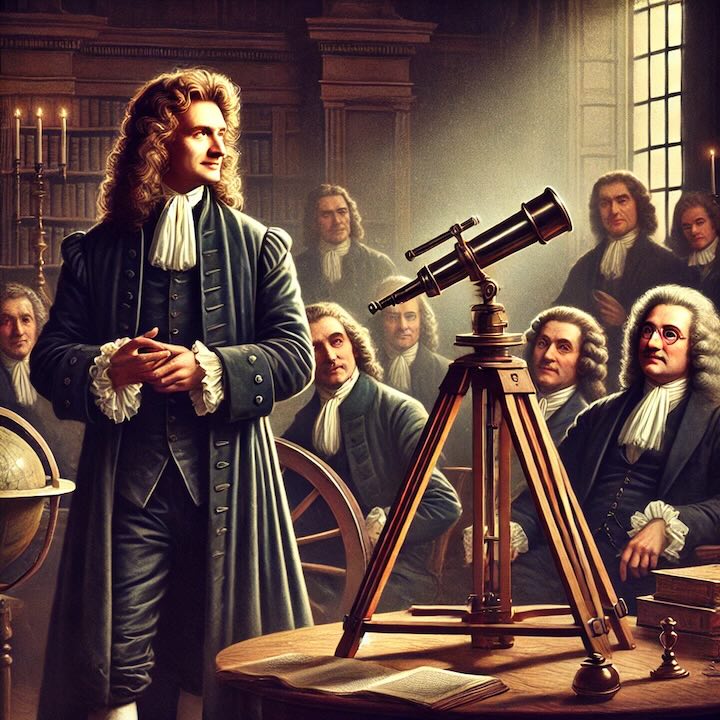
In 1672 Isaac Newton presented to the Royal Society in England his reflecting telescope. The telescope was the fruit of Newton's work on optical studies.
In 1672, Isaac Newton presented his groundbreaking reflecting telescope to the Royal Society in England, marking a significant achievement in both astronomy and optical science. The presentation of the telescope was the culmination of Newton’s work on the nature of light and his innovative approach to addressing the limitations of existing telescope designs. Newton’s reflecting telescope was not only smaller and more powerful than the refracting telescopes of the time, but it also solved a critical problem: chromatic aberration.
Before Newton’s contribution, the dominant design for telescopes was the refracting telescope, which used lenses to magnify distant objects. However, refracting telescopes suffered from a significant flaw known as chromatic aberration, where different colors of light were refracted (or bent) by different amounts, causing a blurred or distorted image. This effect arose because glass lenses refracted various wavelengths of light unequally, and despite attempts to correct it, the issue persisted, limiting the effectiveness of these telescopes.
Newton, who had been deeply engaged in optical studies, realized that the problem of chromatic aberration could be avoided by using mirrors instead of lenses to gather and focus light. Mirrors, unlike lenses, do not disperse light into its component colors, thus eliminating the chromatic aberration problem. Newton’s telescope employed a curved primary mirror to collect light and reflect it to a secondary mirror, which then directed the image to an eyepiece for observation. This configuration—now known as a reflecting telescope—was a major innovation that paved the way for more powerful and compact telescopes.
The reflecting telescope that Newton built was only about six inches long, much shorter than the refracting telescopes of the time, which were often several feet long. Despite its smaller size, Newton’s telescope provided clearer and more magnified images of celestial objects. This compact design was revolutionary because it allowed for better portability and ease of use, without sacrificing the quality of the images.
Newton’s optical work, including his experiments with light and color, had a profound influence on his telescope design. He had previously discovered that white light could be split into its component colors using a prism, demonstrating that light was made up of a spectrum of colors. This realization led Newton to reject the idea that lenses could be improved to eliminate chromatic aberration. Instead, he turned to mirrors, which reflected light without splitting it into different colors.
The Royal Society was highly impressed with Newton’s reflecting telescope, and it quickly became a key tool for astronomers. The success of the reflecting telescope demonstrated the practical application of Newton’s theories of optics and established his reputation as a leading scientist of his time. In fact, Newton’s work on the telescope contributed to his election as a fellow of the Royal Society, and the device itself became one of the early models for future telescope designs.
Newton’s reflecting telescope also laid the groundwork for many future advancements in astronomy. Modern telescopes, including large observatory telescopes and even space-based telescopes like the Hubble Space Telescope, are based on the reflecting principle that Newton pioneered. His invention remains a lasting legacy in both the fields of optics and astronomy.
 >
>